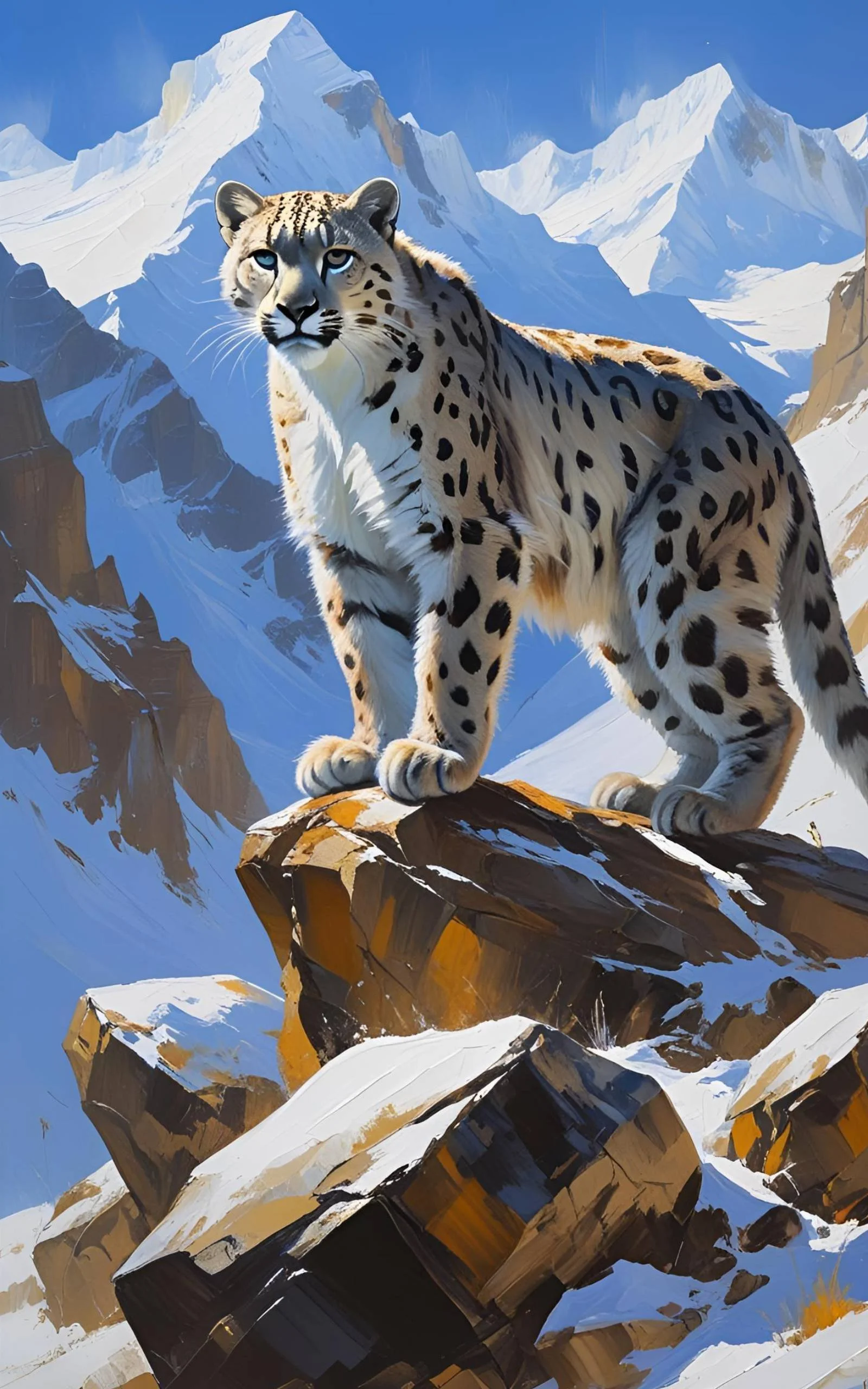Animal #07: The Snow Leopard – Serving Looks, Avoiding Eye Contact
If you’ve ever seen a picture of a snow leopard and thought, Wow, that creature is majestic, mysterious, and probably writes poetry in its spare time, you’re not wrong. Snow leopards have the uncanny ability to look both ethereal and deeply unimpressed at the same time. With their thick, dappled fur, pale eyes, and tendency to vanish into cliffs like a ghost with commitment issues, they seem like the introvert’s answer to a fashion icon.
But don’t let the glamour fool you—beneath all that elegance lies a solitary, surprisingly flatulent carnivore with a powerful left hook and a deep personal aversion to being perceived.
Looks That Could Kill (And Have)
Let’s start with the fur—because it’s the first thing that makes people lose their minds. The snow leopard’s coat is thick, smoky-grey, and patterned with rosettes and spots so stunning that humans once regularly risked jail time just to turn one into a rug. It’s not just beautiful; it’s functional. That dramatic fluff? It’s insulation. Those big, snowshoe-like paws? Winter boots. And the absurdly long tail? It’s a scarf, blanket, balance pole, and dramatic exit flourish all in one.
Basically, the snow leopard is out here surviving -40°C Himalayan winters while looking like it just stepped off the cover of Vogue: Endangered Species Edition.
Eat, Leap, Vanish: The Secret Life of a Snow Leopard
Snow leopards live in the highest, harshest terrain on Earth—from the Himalayas to the mountains of Mongolia—where the air is thin, the cliffs are sheer, and the Wi-Fi is nonexistent. They spend most of their time alone, avoiding both humans and each other, presumably so they don’t have to explain their plans.
They can leap up to 15 metres (about 50 feet) in a single bound, which is enough to land them squarely in the “impossible” category alongside kangaroos and emotionally available men. This ability makes them exceptional hunters, able to ambush mountain goats, ibex, and the occasional unlucky bird. And when they do make a kill? They drag it to a ledge, eat a little, nap a lot, and come back later. No rush. No notes.
Their daily routine consists of scaling cliffs, silently judging the local wildlife, and disappearing before anyone gets too attached.
The Ghost of the Mountain Is Not Taking Visitors
Snow leopards are famously hard to spot. In fact, they’re so elusive that researchers mostly track them via motion-activated cameras—because of course the snow leopard is that friend who leaves a party before anyone knows they were there.
They don’t roar (thanks to a differently shaped larynx), but they do produce a low, breathy chuff called a prusten. It’s essentially the cat equivalent of a soft exhale that says, “I acknowledge your existence but won’t be engaging further.”
Even their footprints are rarely seen in the snow, which has earned them the nickname “Ghost of the Mountain.” Which, if we’re being honest, sounds like a discontinued perfume from the 90s—and they’d totally wear it.
Fluffy, Fierce, and Fully Booked
Despite their cuddly appearance, snow leopards are not interested in your friendship. They’re territorial, solitary, and fiercely private. The only time they willingly share space with another snow leopard is during mating season—or when raising cubs, in the case of the females.
A snow leopard mother will give birth to two or three cubs in a rocky den, care for them with militant tenderness, and then release them into the world to become their own mysterious, emotionally distant selves. A legacy of solitude, fluff, and grace.
And while they might look huggable, they come equipped with teeth, claws, and the raw, quiet rage of someone who has been trying to rest for 22 hours and just heard a twig snap.
Conservation: Because Beauty Doesn’t Equal Safety
Despite their aloofness (or maybe because of it), snow leopards are in trouble. Climate change, poaching, and habitat loss have pushed them onto the vulnerable species list. There are estimated to be fewer than 7,000 left in the wild—though that number is shaky, since snow leopards aren’t exactly lining up for the census.
They’ve been hunted for their fur, retaliated against by farmers protecting livestock, and squeezed into smaller, colder corners of their already-remote habitat.
Conservation groups are now working hard to protect both the snow leopards and the communities that live alongside them, because—surprise—ecosystems need balance, and snow leopards are kind of a big deal in theirs.
The Snow Leopard Is a Vibe, Not a Pet (unfortunately)
Snow leopards are walking contradictions. They look like they belong in a Lisa Frank dreamscape, but they live in absolute isolation. They seem ethereal and gentle, but they can crush your ribcage in one well-timed pounce. They are majestic, moody, and unavailable for interviews.
And that, in a world that can’t stop oversharing, makes them incredibly appealing.
Because really—aren’t we all just emotionally tired snow leopards trying to find a quiet cliff to disappear onto, wrapped in our metaphorical tail, hoping no one asks us to join a Zoom call?








